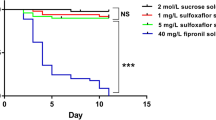Abstract
Chlorpyrifos, an organophosphate (OP) pesticide, possess broad-spectrum insecticidal activity against Lepidoptera, Diptera, Homoptera, Coleoptera, Orthoptera, Hymenoptera, and Hemiptera. Organophosphate pesticides have acute neurotoxicity because they suppress acetylcholine esterase (AChE) which regulates the enzyme of neurotransmitters by reducing acetylcholine concentration at synaptic junctions. On exposure to OP, AChE is inactivated and leads to accumulation of acetylcholine in the junction. Moreover, due to their persistence nature they biomagnify at different food chain levels. In the present study, a newly isolated indigenous bacterial strain Tistrella sp. AUC10 was exploited for its ability to degrade chlorpyrifos pesticide. The isolate completely degrades (99.86%) chlorpyrifos. The degraded metabolites of chlorpyrifos by Tistrella sp. AUC10 were identified by GC–MS analysis. Based on the GC–MS analysis, a putative pathway of degradation of chlorpyrifos by Tistrella sp. AUC10 has been proposed. It emulsified various hydrocarbons and also confirms biosurfactant production on CTAB agar. This study is the first report on elucidation of the mechanism of degradation of chlorpyrifos by Tistrella sp. Furthermore, phytotoxicity studies of the parent compound and the biodegraded chlorpyrifos products revealed drastic reduction in the toxicity of metabolites as compared to the parent chlorpyrifos. This implies that the biodegraded metabolites of chlorpyrifos are of non-toxic nature. This study thus indicates the efficacy of Tistrella sp. AUC10 for the treatment of chlorpyrifos contaminated agricultural fields.




Similar content being viewed by others
References
Ahir UN, Vyas TK, Sutaria BP et al (2018) Screening of bacteria for their chlorpyrifos degrading ability. Int J Curr Microbiol App Sci 7:10–17. https://doi.org/10.20546/ijcmas.2018.708.002
Akbar S, Sultan S (2016) Soil bacteria showing a potential of chlorpyrifos degradation and plant growth enhancement. Braz J Microbiol. https://doi.org/10.1016/j.bjm.2016.04.009
Jabeen H, Iqbal S, Anwar S (2015) Biodegradation of chlorpyrifos and 3, 5, 6-trichloro-2-pyridinol by a novel rhizobial strain Mesorhizobium sp. HN3. Water Environ J. https://doi.org/10.1111/wej.12081
Saulsbury MD, Heyliger SO, Wang K, Round D (2008) Characterization of chlorpyrifos-induced apoptosis in placental cells. Toxicology. https://doi.org/10.1016/j.tox.2007.10.020
Arshad M, Siddiqa M, Rashid S et al (2016) Biomonitoring of toxic effects of pesticides in occupationally exposed individuals. Saf Health Work 7:156–160. https://doi.org/10.1016/j.shaw.2015.11.001
Menon P, Gopal M, Prasad R (2004) Influence of two insecticides, chlorpyrifos and quinalphos, on arginine ammonification and mineralizable nitrogen in two tropical soil types. J Agric Food Chem. https://doi.org/10.1021/jf049502c
Shan M, Fang H, Wang X, Feng B, Chu XM, Yu YL (2006) Effect of chlorpyrifos on soil microbial populations and enzyme activities. J Environ Sci 18:4–5
Vyas TK, Dave BP (2010) Effect of addition of nitrogen, phosphorus and potassium fertilizers on biodegradation of crude oil by marine bacteria. Indian J Mar Sci 39:143–150
Vyas TK, Dave BP (2011) Production of biosurfactant by Nocardia otitidiscaviarum and its role in biodegradation of crude oil. Int J Environ Sci Technol. https://doi.org/10.1007/BF03326229
Racke KD, Fontaine DD, Yoder RN, Miller JR (1994) Chlorpyrifos degradation in soil at termiticidal application rates. Pestic Sci. https://doi.org/10.1002/ps.2780420108
Mallick K, Bharati K, Banerji A et al (1999) Bacterial degradation of chlorpyrifos in pure cultures and in soil. Bull Environ Contam Toxicol. https://doi.org/10.1007/s001289900840
Singh BK, Walker A, Morgan JAW, Wright DJ (2004) Biodegradation of chlorpyrifos by enterobacter strain B-14 and its use in bioremediation of contaminated soils. Appl Environ Microbiol. https://doi.org/10.1128/AEM.70.8.4855-4863.2004
Anwar S, Liaquat F, Khan QM et al (2009) Biodegradation of chlorpyrifos and its hydrolysis product 3,5,6-trichloro-2-pyridinol by Bacillus pumilus strain C2A1. J Hazard Mater. https://doi.org/10.1016/j.jhazmat.2009.02.059
Chen S, Liu C, Peng C et al (2012) Biodegradation of chlorpyrifos and its hydrolysis product 3,5,6-trichloro-2-pyridinol by a new fungal strain cladosporium cladosporioides Hu-01. PLoS ONE 7:1–12. https://doi.org/10.1371/journal.pone.0047205
El-Helow ER, Badawy MEI, Mabrouk MEM et al (2013) Biodegradation of chlorpyrifos by a newly isolated bacillus subtilis strain, Y242. Bioremediat J. https://doi.org/10.1080/10889868.2013.786019
Richins RD, Kaneva I, Mulchandani A, Chen W (1997) Biodegradation of organophosphorus pesticides by surface-expressed organophosphorus hydrolase. Nat Biotechnol. https://doi.org/10.1038/nbt1097-984
Wang YL, Hua RM, Tang XY et al (2011) Colonization and chlorpyrifos degradation of strain Stenotrophomonas acidaminiphila lux-β in soil. Environ Eng Manag J 10:809–812. https://doi.org/10.1109/RSETE.2011.5965402
Roberts TR, Hutson DH (1999) Metabolic pathways of agrochemicals. Part 2: insecticides and fungicides. The Royal Society of Chemistry, Cambridge, pp 235–242
Duirk SE, Collette TW (2006) Degradation of chlorpyrifos in aqueous chlorine solutions: pathways, kinetics, and modeling. Environ Sci Technol 40:546–551. https://doi.org/10.1021/es0516615
Gebremariam SY (2011) Mineralization, sorption and desorption of chlorpyrifos in aquatic sediments and soils. Ph. D. Thesis. Department of Civil Environmental Engineering, Washington State University, p. 198.
Mutua GK, Ngigi AN, Getenga ZM (2015) Chlorpyrifos degradation in soils with different treatment regimes within Nzoia river drainage basin, Kenya. Bull Environ Contam Toxicol 94:387–392. https://doi.org/10.1007/s00128-015-1465-0
Minas K, Mcewan NR, Newbold CJ, Scott KP (2011) Optimization of a high-throughput CTAB-based protocol for the extraction of qPCR-grade DNA from rumen fluid, plant and bacterial pure cultures. FEMS Microbiol Lett. https://doi.org/10.1111/j.1574-6968.2011.02424.x
Vyas TK, Murthy SR (2015) Chlorobenzene degradation by Bacillus sp. TAS6CB: a potential candidate to remediate chlorinated hydrocarbon contaminated sites. J Basic Microbiol. https://doi.org/10.1002/jobm.201200758
Siegmund I, Wagner F (1991) New method for detecting rhamnolipids excreted by Pseudomonas species during growth on mineral agar. Biotechnol Tech. https://doi.org/10.1007/BF02438660
Johnson MK, Boese-Marrazzo D (1980) Production and properties of heat-stable extracellular hemolysin from Pseudomonas aeruginosa. Infect Immun 29(3):1028–1033
Peter JK, Singh DP (2014) Characterization of emulsification activity of partially purified Rhamnolipids from Pseudomonas fluorescens. Int J Innov Sci Res 3(1):88–100
Busenell LD, Haas HF (1941) The utilization of certain hydrocarbons by microorganisms. J Bacteriol 29(3):1028–1033
Venugopal NVS, Sumalatha B, Sainadh NVS (2013) Determination of chloropyrifos-a new approach. Adv Chem Sci 2(4):83–87
AOAC (2007) Pesticide residues in foods by acetonitrile extraction and partitioning with magnesium sulfate. In: Official Methods of Analysis. Association of Official Analytical Chemists, Gaithersburg
Cooper DG, Goldenberg BG (1987) Surface-active agents from two Bacillus species. Appl Environ Microbiol 53:224
Santhoshkumar M, Baskaran L, Mahakavi T, Ravi T (2015) Chlorpyrifos toxicity in green gram (Vigna radiata L.). J Environ Treat Tech 3(1):25–27
Shi B-H, Arunpairojana V, Palakawong S, Yokota A (2002) Tistrella mobilis gen. nov., sp. nov., a novel polyhydroxyalkanoate producing bacterium belongs to α-Proteobacteria. J Gen Appl Microbiol 48:335–343
Xu Y, Kersten RD, Nam S-J, Lu L, Al-Suwailem AM, Zheng H, Fenical W, Dorrestein PC, Moore BS, Qian P-Y (2012) Bacterial biosynthesis and maturation of didemnin anticancer agent. J Am Chem Soc 134(20):8625–8632. https://doi.org/10.1021/ja301735a
Kavithta D, Sureshkumar M, Senthilkumar B (2016) Screening of pesticide degrading and biosurfactant producing bacteria from chlopyrifos contaminated soil. Int J Pharm Bio Sci 7(3):525–532
Singh BK, Walker A, Morgan JAW, Wright DJ (2003) Effects of soil pH on the biodegradation of chlorpyrifos and isolation of a chlorpyrifos-degrading bacterium. Appl Environ Microbiol. https://doi.org/10.1128/AEM.69.9.5198-5206.2003
Kiss A, Virág D (2009) Photostability and photodegradation pathways of distinctive pesticides. J Environ Qual. https://doi.org/10.2134/jeq2007.0504
Elbialy ZI, Ismail T, Abdelhady DH, Elasely AM (2015) Assessment of genotoxic effects of pesticide residues and related haemato-biochemical parameters on farmed nile tilapia ( Oreochromis Niloticus L) in Kafrelsheikh Governorate. Alexandria J Vet Sci 44:136–146. https://doi.org/10.5455/ajvs.176708
Acknowledgement
Authors are thankful to Navsari Agricultural University, Navsari, Gujarat, India for providing all facility to conduct work.
Author information
Authors and Affiliations
Corresponding author
Additional information
Publisher's Note
Springer Nature remains neutral with regard to jurisdictional claims in published maps and institutional affiliations.
Electronic supplementary material
Below is the link to the electronic supplementary material.


Rights and permissions
About this article
Cite this article
Ahir, U.N., Vyas, T.K., Gandhi, K.D. et al. In Vitro Efficacy for Chlorpyrifos Degradation by Novel Isolate Tistrella sp. AUC10 Isolated from Chlorpyrifos Contaminated Field. Curr Microbiol 77, 2226–2232 (2020). https://doi.org/10.1007/s00284-020-01998-1
Received:
Accepted:
Published:
Issue Date:
DOI: https://doi.org/10.1007/s00284-020-01998-1




